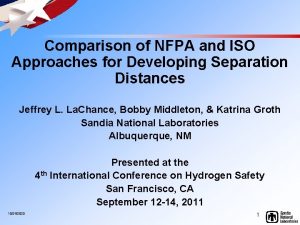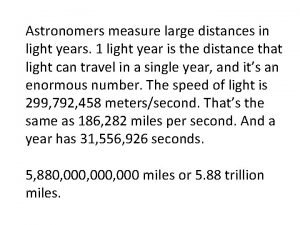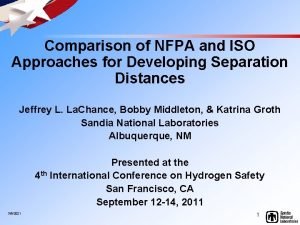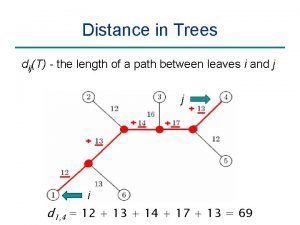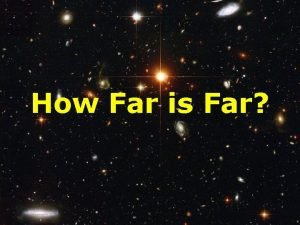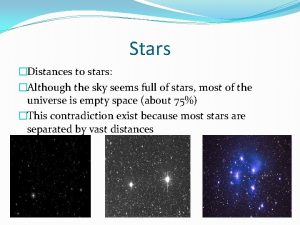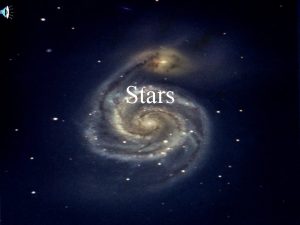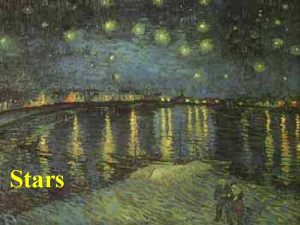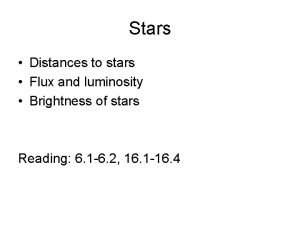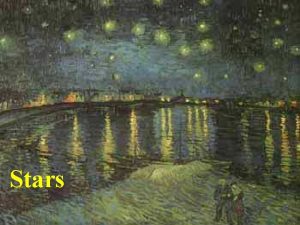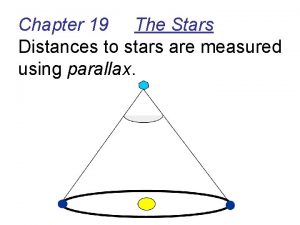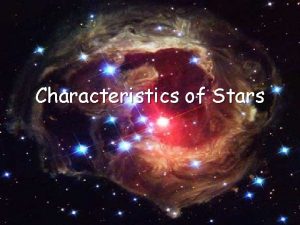Stars Distances to stars Although the sky seems














- Slides: 14

Stars �Distances to stars: �Although the sky seems full of stars, most of the universe is empty space (about 75%) �This contradiction exist because most stars are separated by vast distances

The Light Year �Because stars are so far apart, it would not be practical to use units used on Earth such as kilometers �Instead they use much lager units like the light year �A light year is the distance light travels in one year, which is about 9. 5 trillion kilometers �Proxima Centauri is the closest star to the sun and it is about 4. 3 light years away

Parallax �Stars are so far away that astronomers cannot measure their distances directly �They have developed various methods of determining the distances of stars �Example: -Hold your thumb at arm’s length in front of you. Then close your left eye at look at your thumb with your right eye. Then switch and close your right eye and look at it with your left eye open. Even though you didn’t move your thumb, it appeared to move relative to the background because you looked at it from a different angle

Parallax �This apparent change in position of an object with respect to a distant background is called a parallax �As Earth moves in its orbit, astronomers are able to observe stars from two different positions �With the invention of the telescope, astronomers could measure the positions of the stars with much greater accuracy �The closer the star is to Earth, the greater is its parallax �Works for stars within a few hundred light-years

Properties of Stars �There are many different types of stars �Classified by their color, size, and brightness �Also by chemical composition and mass

Color and Temperature �Have you ever looked at a candle flame? (The hottest part near the wick is blue or white, while the cooler flame is orange) A propane torch is blue and a dying camp fire is red �You can estimate the temperature by the color it produces (This can be applied to the color of stars) �The hottest stars above 30, 000 Kelvin’s appear blue �Red stars are 3, 000 Kelvin’s and 5, 000 -6, 000 Kelvin’s like the sun are yellow

Brightness �If you look at a row of street lights the closer ones appear to be brighter, however the distant lights are not really dimmer they just appear that way because at a greater distance their light is spread out over a greater area (The same holds true for stars) �The sun appears to be the brightest star we can see because it is so close to us (The sun is much cooler than many stars) �The brightness of a star as it appears from Earth is called apparent brightness �Absolute brightness is how bright the star really is

Size and Mass �Once astronomers know a star’s temperature and absolute brightness, they can estimate its diameter and then calculate its volume �Astronomers are able to calculate the masses of many stars by observing the gravitational interaction of stars that occur in pairs �Astronomers have determined there is a relationship between mass and absolute brightness (have found many stars similar to the sun in size/mass)

Composition �A spectrograph is an instrument that spreads light into a spectrum (Can be used to identify various elements in a star’s atmosphere) �Each star has its own spectrum (Each element absorbs light at different wavelengths, removing these wavelengths from the star’s spectrum) �Each spectrum contains dark lines called absorption lines (shows where light has been absorbed)

Composition �Can be used like finger prints to identify elements in a star �Most star’s have a chemical makeup with hydrogen and helium together making up 96 -99. 9% of the star’s mass (Similar to the sun)

The Hertzsprung-Russell Diagram �Is a graph of the surface temperature, or color, and absolute brightness of a sample of stars �Used to estimate the sizes of the stars and their distances, and to infer how stars change over time �Horizontal axis shows the surface temperature of stars, (Hottest stars “Blue” on left Cooler stars “Red” on right) �Vertical axis shows absolute brightness, with brightest stars on top and faintest on bottom

Main-Sequence Stars �On the H-R diagram most stars are found along a diagonal band running from bright hot stars on the upper left to the dim cool stars on the lower right �Diagonal band is called “main sequence” �About 90% of all stars are found on the main sequence �Our sun is near the middle of this band

Giants and Dwarfs � 2 factors determine a stars absolute brightness: -its size and surface temperature �Because the H-R diagram shows a star’s absolute brightness and surface temperature, you can estimate the star’s size �If 2 stars at the same temperature, the brighter star must be larger, also hotter stars are brighter than cooler stars of the same size

Giants and Dwarfs �The very bright stars at the upper right hand corner of the H-R diagram are called super-giants �Super-Giants are much brighter than main sequence stars of the same temperature �They range from 100 -1, 000 times the diameter of the sun �The next biggest are Giants which are large, bright stars that are smaller/fainter than super-giants �Below the main sequence in the lower part is the white dwarfs (a small dense remains of a low-medium mass star
 The stars there are millions of stars in the sky
The stars there are millions of stars in the sky Little dipper
Little dipper Nfpa separation distances
Nfpa separation distances Distances
Distances Hexagon test components
Hexagon test components Images of weather systems on television come from
Images of weather systems on television come from The furthest distances i've travelled
The furthest distances i've travelled Astronomers measure large distances
Astronomers measure large distances Nfpa separation distances
Nfpa separation distances It measures the vertical distance
It measures the vertical distance Tree distances i
Tree distances i Far distances
Far distances Calm area where warm air rises
Calm area where warm air rises How do waves form
How do waves form The distance covered per unit of time
The distance covered per unit of time


